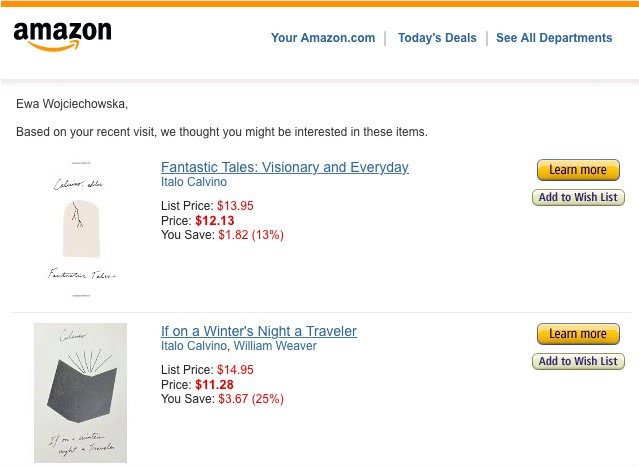 Is wishlist a magic wand that cures all e-commerce maladies, from abandoned carts to poor customer engagement to small sales? Don’t count on an easy answer: all depends on your product range and your ability to combine the tool with Marketing Automation systems.
Is wishlist a magic wand that cures all e-commerce maladies, from abandoned carts to poor customer engagement to small sales? Don’t count on an easy answer: all depends on your product range and your ability to combine the tool with Marketing Automation systems.
What is a wishlist?
The wish list is a feature that allows customer mark items she is interested in, but can’t buy them at them moment. However, she shows an intention to do so in the future. That way a wish list – a collection of desired products – is displayed in user’s profile. That way a customer who can’t buy an item out of objective reasons will find it easier to make a purchase later, when obstacles are overcome.
A wish list can also be shared and made public, so other can see what a given person would like to get. It’s extremely helpful when it comes to gifts: taking a peek on somebody’s wish list removes the risk of buying an unwanted present. That practical function also spreads your brand, as people like to send their wish list to each other.
Turn visitors into loyal customers: download free ebook on Lead Nurturing
How customers use wishlist?
Customers use wish lists in many ways, not only as reminders of things to buy. They often mark products that they want to buy cheaper. If you don’t need something urgently, you can wait for the prize to drop. Also often wish lists aren’t treated as lists of things to buy, but rather as inspirational mood boards or gifts lists.
And, last but not least, consumers forget about products added to wish lists in many stores, so reminding them with dynamic emails seems vital.
How Amazon does it
There is one price of wish lists – undoubtedly, Jeff Bezos. For him, this tool empowers customers giving them freedom and control to plan their shopping at their pace and according to their plans. When you observe Amazon’s actions, you will notice that “Add to Wishlist” button is omnipresent on their website and in emails (see a dynamic 1-to-1 email below). It defies most marketers’ “Don’t distract!” mantra. Instead of forcing a customer to checkout, Amazon shows many offers and seems to say: “Take your time, buy what you need, mark some products for later”.
It gives power to the customer. Would you be ready to do the same?

Amazon uses “add to Wishlist” button also in emails.
Pros of wishlist
Why wish list is a great feature for your e-commerce?
– It helps navigate if your have many products in your offer. Browsing endless catalogues to find the perfect item can annoy anyone. It’s the idea of long search that discourages many people from shopping. If you let them mark preferred items, next time they will have only to come and buy, without a need to look for the product again.
– It engages customers even if they don’t buy. Wishlist helps customers develops a habit of visiting your website and actively viewing your offer. Window shopping can be turned into the future purchase.
– It builds loyalty. Wishlist makes users come back and encourages them to think about the company in terms of the future (“I’ll buy it later”, “I’ll go back for it next month”).
– I t gives customers an impression that their shopping is well planned and rational. If you added a product to your wish list and after two months you still like it, buying it feels justified. It’s not a purchase made on a whim, right? It also meets the needs of slow buyers: customers who show different buying temperament and prefer to give each transaction a think.
Cons of wishlist
Adversaries point out that wish list can encourage customers to add items to list instead of buying, that it distracts from check-out and provides multiple options instead of one. If a customer can add new products to the list, she might just wait ad infinitum for them to get cheaper or for herself to be sure.
And at the end of the day marketers task is to drive sales, not wishes. Wishes won’t pay the bills, will they?
When should you implement wish list?
Consider applying wish list when you if the following statements are true for you:
1) You have a broad range of products in your e-store,
2) You have software to use data from wishlist to marketing communication with individual customers (for example, to deepen insight into their preferences) and for general knowledge (react when a product is often added to wishlist),
3) Your products can be given as gifts.
Support wishlist with Marketing Automation
Let’s underline this: introducing this feature without a broader strategy including Marketing Automation is a pure art for art’s sake. It won’t deliver any results, on the contrary, can lower sales. Wishlist must be combined with actions such as:
– Email marketing: emails reminding about products from the list, about discount on items from the list, telling about possibility to share list with friends,
– Personalization: more knowledge on customers’ preferences help tailor offers more precisely,
– Scoring: add scoring points for adding item to wish list,
– E-store optimization: discovering which products are frequently added to the list you get a bird-eye view and know which products to expose better.
How about you? Do you use wish list in your e-store?
 Follow
Follow
















